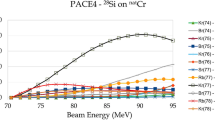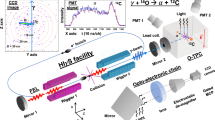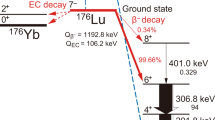Abstract
IN order to investigate the energy distribution of the -rays from radio-helium1, we have employed an expansion chamber constructed by Dr. J. C. Jacobsen and kindly lent to us. In the middle of the top plate, a thin-walled brass cylinder (0.05 gm. per cm.2, 1.5 cm. diameter) was inserted, into which an activated beryllium cylinder could be dipped. The latter was made of beryllium powder (0.12 gm. per cm.2) stuck on to a brass tube (0.1 gm. per cm.2) and could be moved automatically from a position around a neutron source (beryllium-radon) to the position in the Wilson chamber in 0.4 sec., this movement also starting the timing arrangement for expansion and light. A suitable lead shielding was arranged which cut down the electrons due to the -rays to a number small compared with the number of -rays. The radioactivity induced in the brass tube carrying the beryllium is negligible as the latter is exposed to the neutrons only for a few seconds at most every minute.
This is a preview of subscription content, access via your institution
Access options
Subscribe to this journal
Receive 51 print issues and online access
$199.00 per year
only $3.90 per issue
Buy this article
- Purchase on Springer Link
- Instant access to full article PDF
Prices may be subject to local taxes which are calculated during checkout
Similar content being viewed by others
References
See preceding letter.
M. L. Oliphant, NATURE, 137, 396 (1936).
M. L. Oliphant, Copenhagen Conf. 1936 (unpublished).
Author information
Authors and Affiliations
Rights and permissions
About this article
Cite this article
BJERGE, T., BROSTRÖM, K. -Ray Spectrum of Radio-Helium. Nature 138, 400–401 (1936). https://doi.org/10.1038/138400b0
Issue Date:
DOI: https://doi.org/10.1038/138400b0
Comments
By submitting a comment you agree to abide by our Terms and Community Guidelines. If you find something abusive or that does not comply with our terms or guidelines please flag it as inappropriate.



